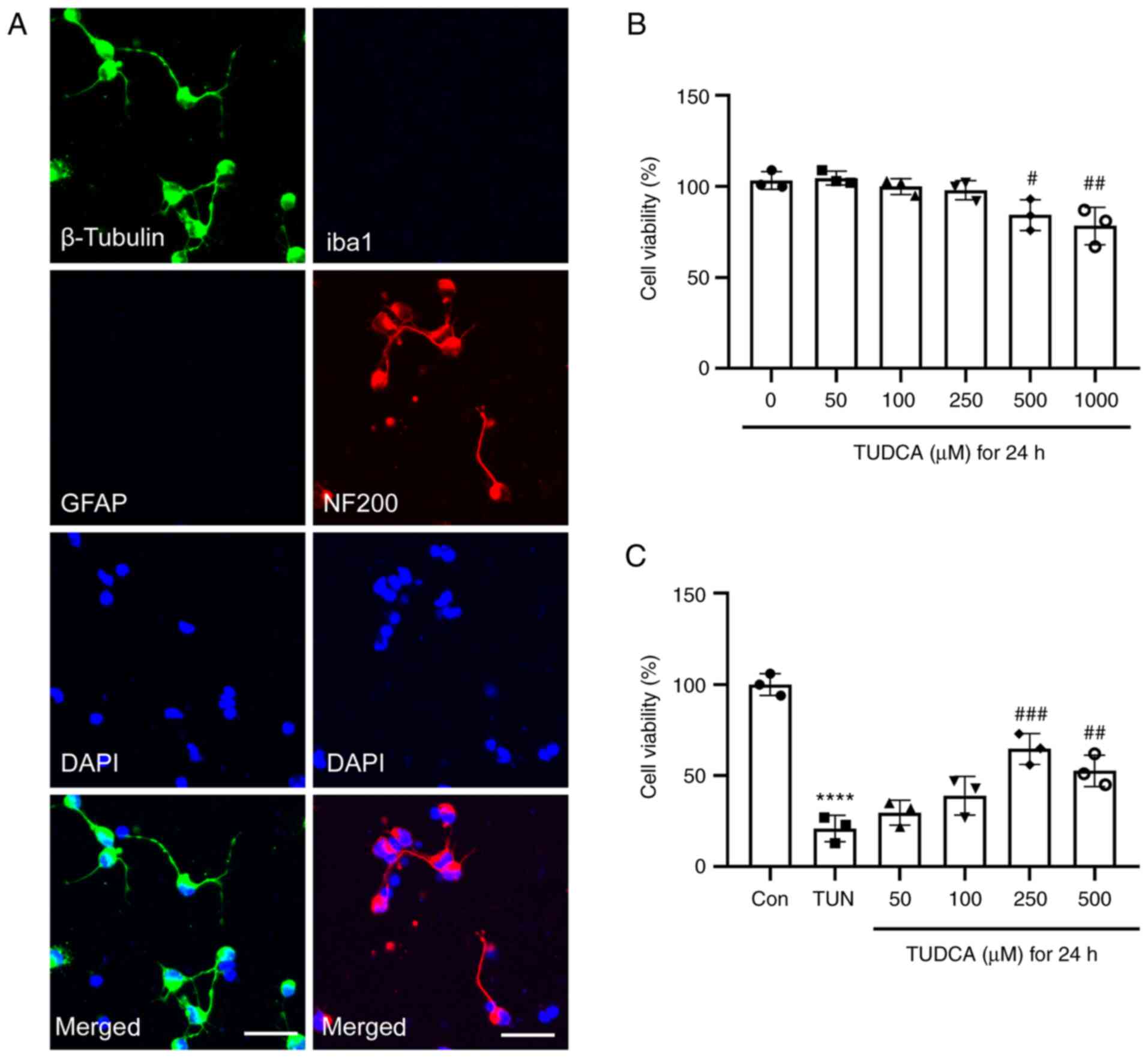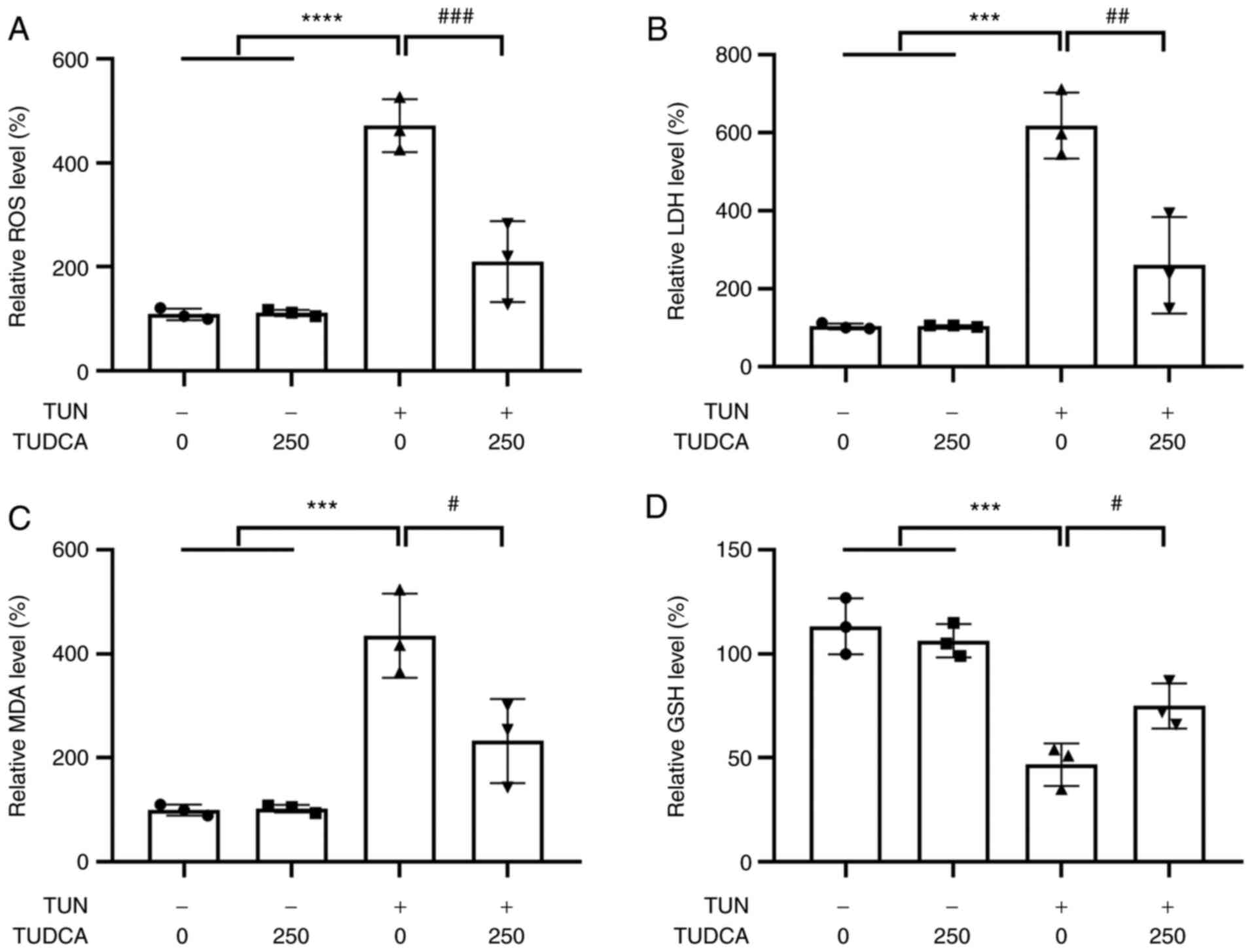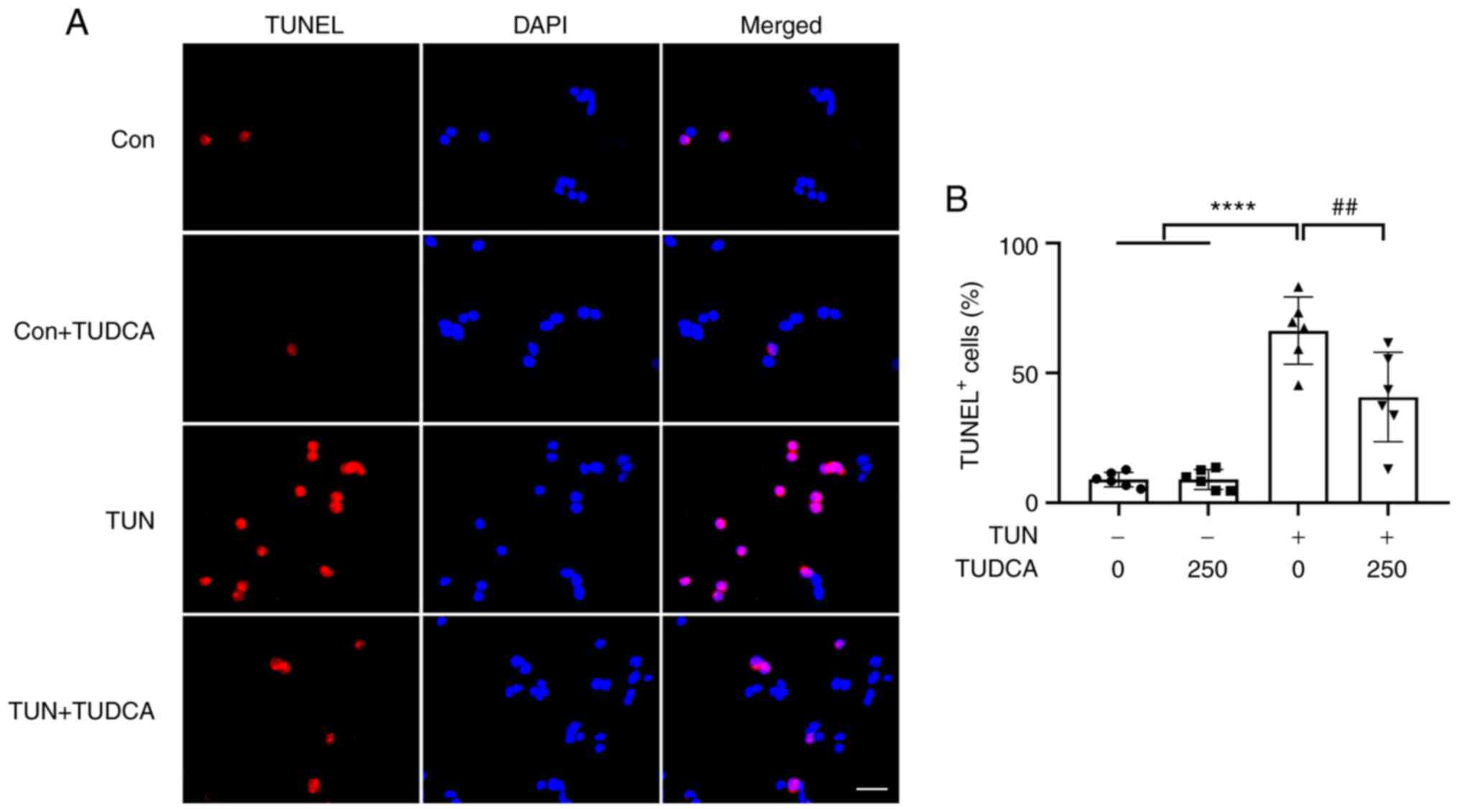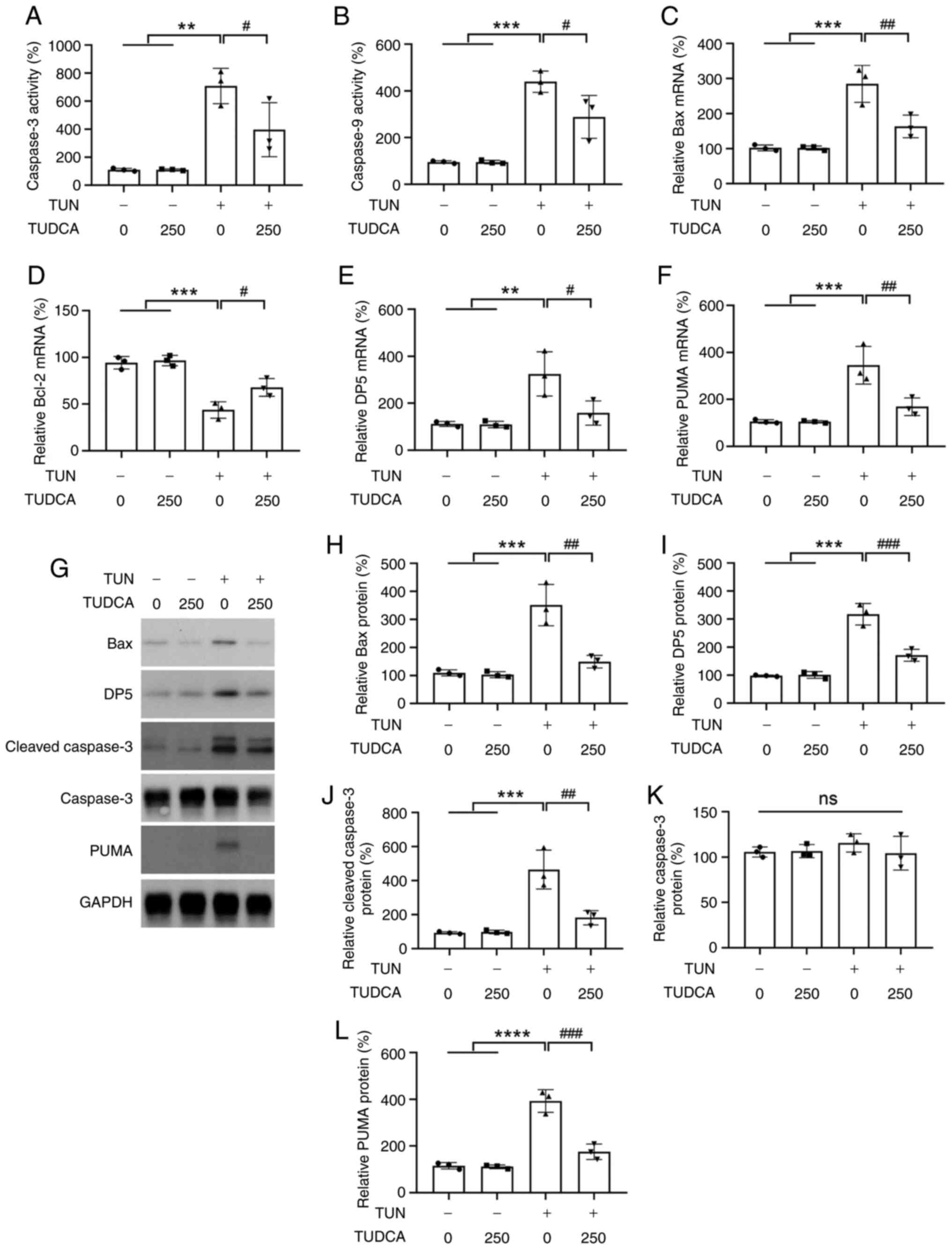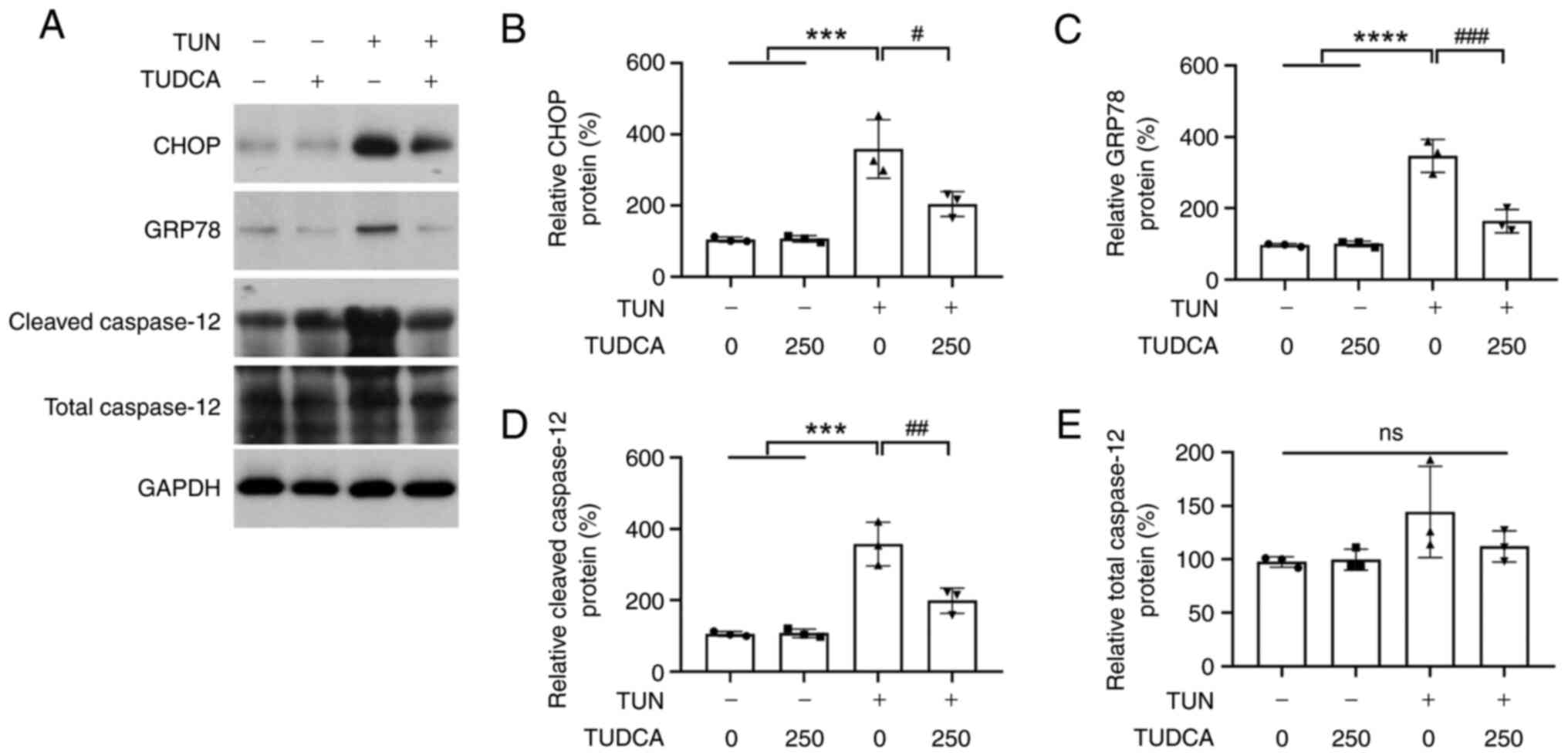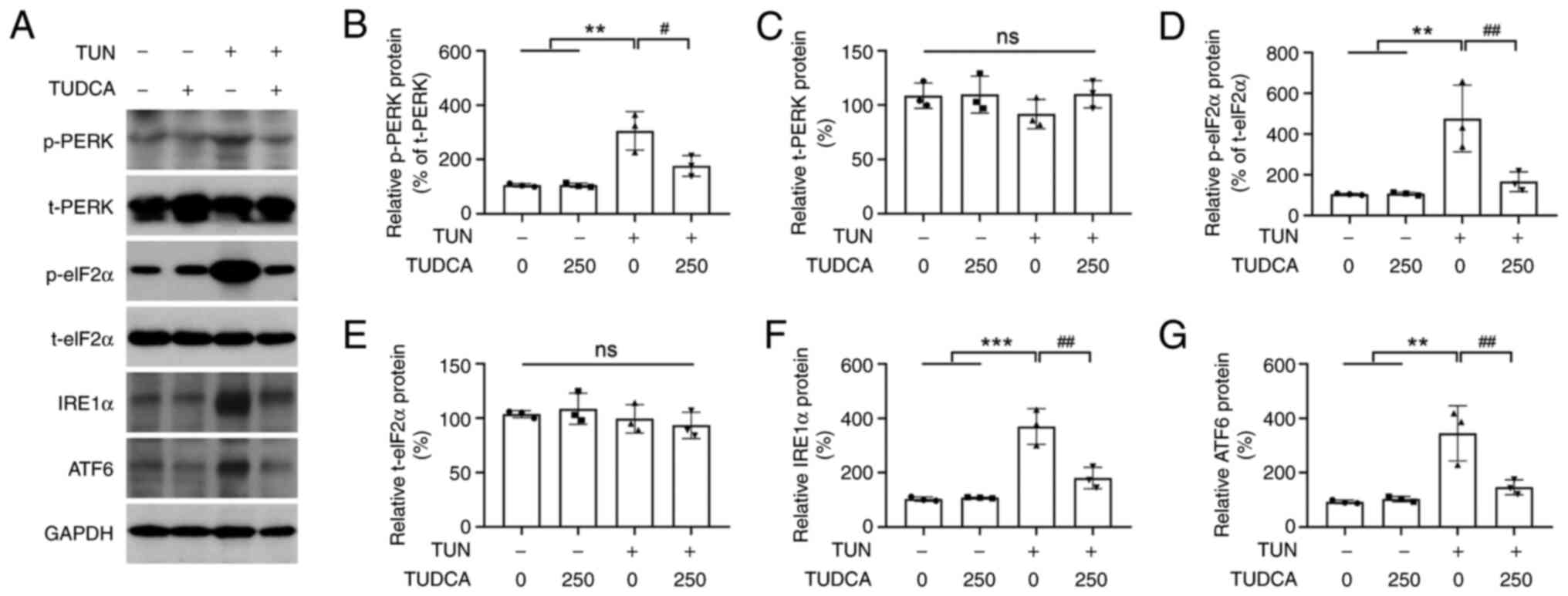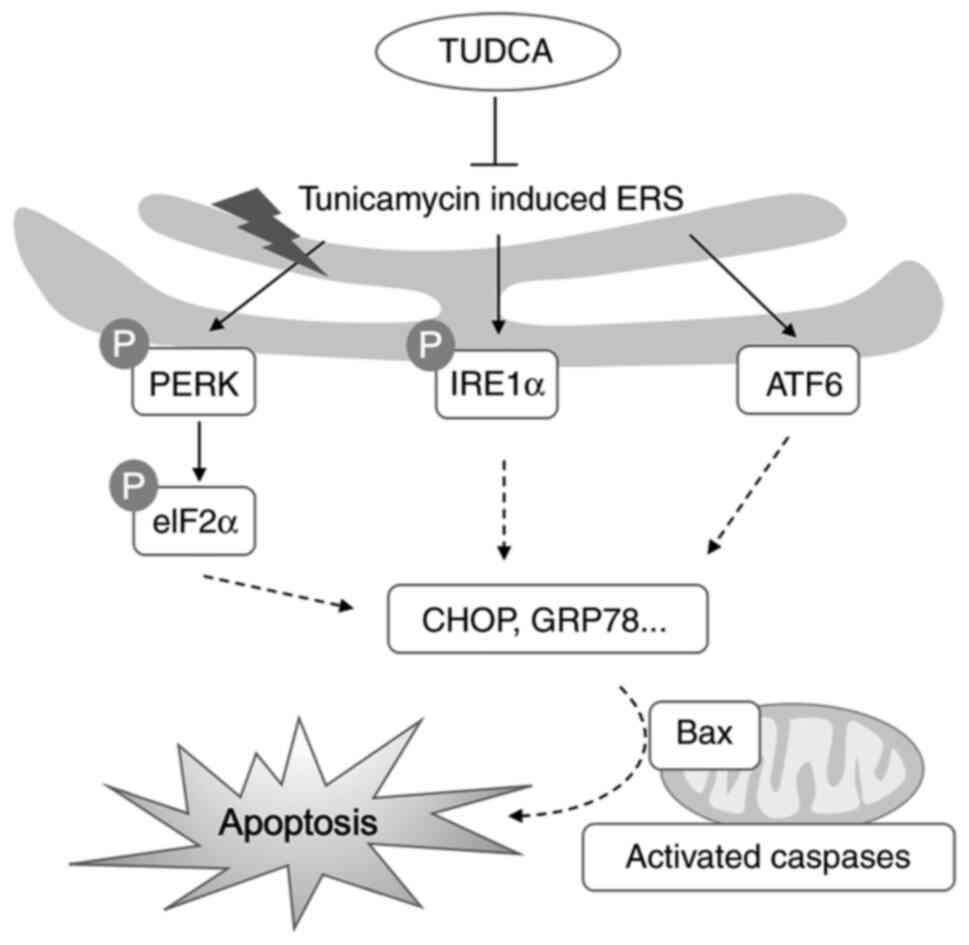|
1
|
Ma H, Zeng M, Han Y, Yan H, Tang H, Sheng
J, Hu H, Cheng L, Xie Q, Zhu Y, et al: A multicenter, randomized,
double-blind trial comparing the efficacy and safety of TUDCA and
UDCA in Chinese patients with primary biliary cholangitis. Medicine
(Baltimore). 95(e5391)2016.PubMed/NCBI View Article : Google Scholar
|
|
2
|
Kusaczuk M: Tauroursodeoxycholate-bile
acid with chaperoning activity: Molecular and cellular effects and
therapeutic perspectives. Cells. 8(1471)2019.PubMed/NCBI View Article : Google Scholar
|
|
3
|
Ozcan U, Yilmaz E, Ozcan L, Furuhashi M,
Vaillancourt E, Smith RO, Görgün CZ and Hotamisligil GS: Chemical
chaperones reduce ER stress and restore glucose homeostasis in a
mouse model of type 2 diabetes. Science. 313:1137–1140.
2006.PubMed/NCBI View Article : Google Scholar
|
|
4
|
Fonseca I, Gordino G, Moreira S, Nunes MJ,
Azevedo C, Gama MJ, Rodrigues E, Rodrigues CMP and Castro-Caldas M:
Tauroursodeoxycholic acid protects against mitochondrial
dysfunction and cell death via mitophagy in human neuroblastoma
cells. Mol Neurobiol. 54:6107–6119. 2017.PubMed/NCBI View Article : Google Scholar
|
|
5
|
Li P, Fu D, Sheng Q, Yu S, Bao X and Lv Z:
TUDCA attenuates intestinal injury and inhibits endoplasmic
reticulum stress-mediated intestinal cell apoptosis in necrotizing
enterocolitis. Int Immunopharmacol. 74(105665)2019.PubMed/NCBI View Article : Google Scholar
|
|
6
|
Yamaguchi Y, Oh-Hashi K, Matsuoka Y,
Takemura H, Yamakita S, Matsuda M, Sawa T and Amaya F: Endoplasmic
reticulum stress in the dorsal root ganglion contributes to the
development of pain hypersensitivity after nerve injury.
Neuroscience. 394:288–299. 2018.PubMed/NCBI View Article : Google Scholar
|
|
7
|
Tan HP, Guo Q, Hua G, Chen JX and Liang
JC: Inhibition of endoplasmic reticulum stress alleviates secondary
injury after traumatic brain injury. Neural Regen Res. 13:827–836.
2018.PubMed/NCBI View Article : Google Scholar
|
|
8
|
Yin Y, Sun G, Li E, Kiselyov K and Sun D:
ER stress and impaired autophagy flux in neuronal degeneration and
brain injury. Ageing Res Rev. 34:3–14. 2017.PubMed/NCBI View Article : Google Scholar
|
|
9
|
Li W, Li W, Leng Y, Xiong Y and Xia Z:
Ferroptosis is involved in diabetes myocardial ischemia/reperfusion
injury through endoplasmic reticulum stress. DNA Cell Biol.
39:210–225. 2020.PubMed/NCBI View Article : Google Scholar
|
|
10
|
Yang Y, Zhou Q, Gao A, Chen L and Li L:
Endoplasmic reticulum stress and focused drug discovery in
cardiovascular disease. Clin Chim Acta. 504:125–137.
2020.PubMed/NCBI View Article : Google Scholar
|
|
11
|
Ashraf NU and Sheikh TA: Endoplasmic
reticulum stress and oxidative stress in the pathogenesis of
non-alcoholic fatty liver disease. Free Radic Res. 49:1405–1418.
2015.PubMed/NCBI View Article : Google Scholar
|
|
12
|
Lebeaupin C, Vallée D, Hazari Y, Hetz C,
Chevet E and Bailly-Maitre B: Endoplasmic reticulum stress
signalling and the pathogenesis of non-alcoholic fatty liver
disease. J Hepatol. 69:927–947. 2018.PubMed/NCBI View Article : Google Scholar
|
|
13
|
Chen X and Cubillos-Ruiz JR: Endoplasmic
reticulum stress signals in the tumour and its microenvironment.
Nat Rev Cancer. 21:71–88. 2021.PubMed/NCBI View Article : Google Scholar
|
|
14
|
Nunes AF, Amaral JD, Lo AC, Fonseca MB,
Viana RJ, Callaerts-Vegh Z, D'Hooge R and Rodrigues CM: TUDCA, a
bile acid, attenuates amyloid precursor protein processing and
amyloid-β deposition in APP/PS1 mice. Mol Neurobiol. 45:440–454.
2012.PubMed/NCBI View Article : Google Scholar
|
|
15
|
Radford H, Moreno JA, Verity N, Halliday M
and Mallucci GR: PERK inhibition prevents tau-mediated
neurodegeneration in a mouse model of frontotemporal dementia. Acta
Neuropathol. 130:633–642. 2015.PubMed/NCBI View Article : Google Scholar
|
|
16
|
Valenzuela V, Jackson KL, Sardi SP and
Hetz C: Gene therapy strategies to restore ER proteostasis in
disease. Mol Ther. 26:1404–1413. 2018.PubMed/NCBI View Article : Google Scholar
|
|
17
|
Lin CR, Yang CH, Huang CE, Wu CH, Chen YS,
Sheen-Chen SM, Huang HW and Chen KH: GADD45A protects against cell
death in dorsal root ganglion neurons following peripheral nerve
injury. J Neurosci Res. 89:689–699. 2011.PubMed/NCBI View Article : Google Scholar
|
|
18
|
Wiberg R, Novikova LN and Kingham PJ:
Evaluation of apoptotic pathways in dorsal root ganglion neurons
following peripheral nerve injury. Neuroreport. 29:779–785.
2018.PubMed/NCBI View Article : Google Scholar
|
|
19
|
Chen F, Wu R, Zhu Z, Yin W, Xiong M, Sun
J, Ni M, Cai G and Zhang X: Wogonin protects rat dorsal root
ganglion neurons against tunicamycin-induced ER stress through the
PERK-eIF2α-ATF4 signaling pathway. J Mol Neurosci. 55:995–1005.
2015.PubMed/NCBI View Article : Google Scholar
|
|
20
|
Levin E, Diekmann H and Fischer D: Highly
efficient transduction of primary adult CNS and PNS neurons. Sci
Rep. 6(38928)2016.PubMed/NCBI View Article : Google Scholar
|
|
21
|
Livak KJ and Schmittgen TD: Analysis of
relative gene expression data using real-time quantitative PCR and
the 2(-Delta Delta C(T)) method. Methods. 25:402–408.
2001.PubMed/NCBI View Article : Google Scholar
|
|
22
|
Yakin M, Seo B and Rich A:
Tunicamycin-induced endoplasmic reticulum stress up-regulates
tumour-promoting cytokines in oral squamous cell carcinoma.
Cytokine. 120:130–143. 2019.PubMed/NCBI View Article : Google Scholar
|
|
23
|
Wu F, Zhang R, Feng Q, Cheng H, Xue J and
Chen J: (-)-Clausenamide alleviated ER stress and apoptosis induced
by OGD/R in primary neuron cultures. Neurol Res. 42:730–738.
2020.PubMed/NCBI View Article : Google Scholar
|
|
24
|
Quan X, Wang J, Liang C, Zheng H and Zhang
L: Melatonin inhibits tunicamycin-induced endoplasmic reticulum
stress and insulin resistance in skeletal muscle cells. Biochem
Biophys Res Commun. 463:1102–1107. 2015.PubMed/NCBI View Article : Google Scholar
|
|
25
|
Hu H, Tian M, Ding C and Yu S: The C/EBP
homologous protein (CHOP) transcription factor functions in
endoplasmic reticulum stress-induced apoptosis and microbial
infection. Front Immunol. 9(3083)2018.PubMed/NCBI View Article : Google Scholar
|
|
26
|
Zangerolamo L, Vettorazzi JF, Solon C,
Bronczek GA, Engel DF, Kurauti MA, Soares GM, Rodrigues KS, Velloso
LA, Boschero AC, et al: The bile acid TUDCA improves glucose
metabolism in streptozotocin-induced Alzheimer's disease mice
model. Mol Cell Endocrinol. 521(111116)2021.PubMed/NCBI View Article : Google Scholar
|
|
27
|
Lu Q, Jiang Z, Wang Q, Hu H and Zhao G:
The effect of tauroursodeoxycholic acid (TUDCA) and gut microbiota
on murine gallbladder stone formation. Ann Hepatol.
23(100289)2021.PubMed/NCBI View Article : Google Scholar
|
|
28
|
Oveson BC, Iwase T, Hackett SF, Lee SY,
Usui S, Sedlak TW, Snyder SH, Campochiaro PA and Sung JU:
Constituents of bile, bilirubin and TUDCA, protect against
oxidative stress-induced retinal degeneration. J Neurochem.
116:144–153. 2011.PubMed/NCBI View Article : Google Scholar
|
|
29
|
Mantopoulos D, Murakami Y, Comander J,
Thanos A, Roh M, Miller JW and Vavvas DG: Tauroursodeoxycholic acid
(TUDCA) protects photoreceptors from cell death after experimental
retinal detachment. PLoS One. 6(e24245)2011.PubMed/NCBI View Article : Google Scholar
|
|
30
|
Kitamura Y, Bikbova G, Baba T, Yamamoto S
and Oshitari T: In vivo effects of single or combined topical
neuroprotective and regenerative agents on degeneration of retinal
ganglion cells in rat optic nerve crush model. Sci Rep.
9(101)2019.PubMed/NCBI View Article : Google Scholar
|
|
31
|
Wu H, Yu N, Wang X, Yang Y and Liang H:
Tauroursodeoxycholic acid attenuates neuronal apoptosis via the
TGR5/SIRT3 pathway after subarachnoid hemorrhage in rats. Biol Res.
53(56)2020.PubMed/NCBI View Article : Google Scholar
|
|
32
|
Bikbova G, Oshitari T, Baba T and Yamamoto
S: Combination of neuroprotective and regenerative agents for
AGE-induced retinal degeneration: In vitro study. Biomed Res Int.
2017(8604723)2017.PubMed/NCBI View Article : Google Scholar
|
|
33
|
Hou Y, Luan J, Huang T, Deng T, Li X, Xiao
Z, Zhan J, Luo D, Hou Y, Xu L and Lin D: Tauroursodeoxycholic acid
alleviates secondary injury in spinal cord injury mice by reducing
oxidative stress, apoptosis, and inflammatory response. J
Neuroinflammation. 18(216)2021.PubMed/NCBI View Article : Google Scholar
|
|
34
|
Duan WM, Rodrigures CMP, Zhao LR, Steer CJ
and Low WC: Tauroursodeoxycholic acid improves the survival and
function of nigral transplants in a rat model of Parkinson's
disease. Cell Transplant. 11:195–205. 2002.PubMed/NCBI
|
|
35
|
Lee JH, Yoon YM and Lee SH: TUDCA-treated
mesenchymal stem cells protect against ER stress in the hippocampus
of a murine chronic kidney disease Model. Int J Mol Sci.
20(613)2019.PubMed/NCBI View Article : Google Scholar
|
|
36
|
Zhao H, Wang Y, Li B, Zheng T, Liu X, Hu
BH, Che J, Zhao T, Chen J, Hatzoglou M, et al: Role of endoplasmic
reticulum stress in otitis media. Front Genet.
11(495)2020.PubMed/NCBI View Article : Google Scholar
|
|
37
|
Wen Y, Zong S, Liu T, Du P, Li H and Xiao
H: Tauroursodeoxycholic acid attenuates cisplatin-induced
ototoxicity by inhibiting the accumulation and aggregation of
unfolded or misfolded proteins in the endoplasmic reticulum.
Toxicology. 453(152736)2021.PubMed/NCBI View Article : Google Scholar
|
|
38
|
Kim EH and Park PH: Globular adiponectin
protects rat hepatocytes against acetaminophen-induced cell death
via modulation of the inflammasome activation and ER stress:
Critical role of autophagy induction. Biochem Pharmacol.
154:278–292. 2018.PubMed/NCBI View Article : Google Scholar
|
|
39
|
Yu X, Wang T, Zhu M, Zhang L, Zhang F,
Jing E, Ren Y, Wang Z, Xin Z and Lin T: Transcriptome and
physiological analyses for revealing genes involved in wheat
response to endoplasmic reticulum stress. BMC Plant Biol.
19(193)2019.PubMed/NCBI View Article : Google Scholar
|
|
40
|
Magallón M, Carrión AE, Bañuls L, Pellicer
D, Castillo S, Bondía S, Navarro-García MM, González C and Dasí F:
Oxidative stress and endoplasmic reticulum stress in rare
respiratory diseases. J Clin Med. 10(1268)2021.PubMed/NCBI View Article : Google Scholar
|
|
41
|
Hwang C, Sinskey AJ and Lodish HF:
Oxidized redox state of glutathione in the endoplasmic reticulum.
Science. 257:1496–1502. 1992.PubMed/NCBI View Article : Google Scholar
|
|
42
|
Victor P, Umapathy D, George L, Juttada U,
Ganesh GV, Amin KN, Viswanathan V and Ramkumar KM: Crosstalk
between endoplasmic reticulum stress and oxidative stress in the
progression of diabetic nephropathy. Cell Stress Chaperones.
26:311–321. 2021.PubMed/NCBI View Article : Google Scholar
|
|
43
|
Cansler SM and Evanson NK: Connecting
endoplasmic reticulum and oxidative stress to retinal degeneration,
TBI, and traumatic optic neuropathy. J Neurosci Res. 98:571–574.
2020.PubMed/NCBI View Article : Google Scholar
|
|
44
|
Nakada EM, Bhakta NR, Korwin-Mihavics BR,
Kumar A, Chamberlain N, Bruno SR, Chapman DG, Hoffman SM, Daphtary
N, Aliyeva M, et al: Conjugated bile acids attenuate
allergen-induced airway inflammation and hyperresponsiveness by
inhibiting UPR transducers. JCI Insight. 4(e98101)2019.PubMed/NCBI View Article : Google Scholar
|
|
45
|
Zhang W, Chen L, Feng H, Wang W, Cai Y, Qi
F, Tao X, Liu J, Shen Y, Ren X, et al: Rifampicin-induced injury in
HepG2 cells is alleviated by TUDCA via increasing bile acid
transporters expression and enhancing the Nrf2-mediated adaptive
response. Free Radic Biol Med. 112:24–35. 2017.PubMed/NCBI View Article : Google Scholar
|
|
46
|
National Research Council (US): Committee
for the Update of the Guide for the Care and Use of Laboratory
Animals. Guide for the care and use of laboratory animals. 8th
edition. National Academies Press, Washington, DC, 2011.
|















